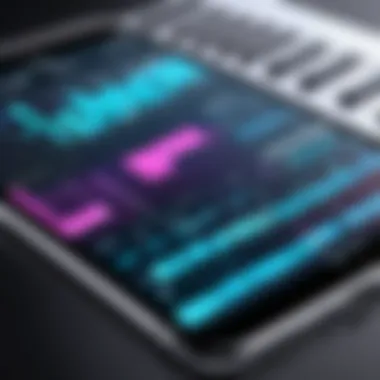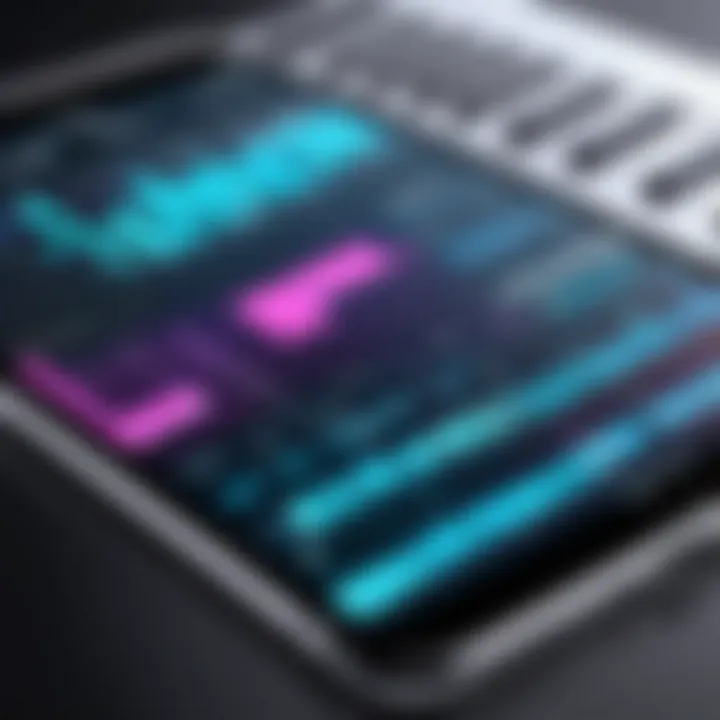Discovering iOS Music Creation Apps: Features and Trends


Intro
In today’s rapidly evolving music landscape, the proliferation of technology has remarkably transformed how music is created, arranged, and enjoyed. Specifically, the Apple ecosystem has nurtured a vibrant array of iOS music-making applications. Musicians, composers, and hobbyists can now pick up their devices, tapping into powerful tools that previously required extensive equipment or studio access.
This article ventures into the diverse range of iOS music-making apps, illuminating their unique capabilities, practical aspects, and how they fit into the creative toolkit of both novices and seasoned professionals. More than just a collection of programs, these applications open the door to musical exploration and innovation.
We will navigate through various categories of apps, analyzing features like ease of use, unique instruments, and workflows that appeal to different levels of users. This deep dive will also encompass the latest trends and techniques that are shaping the landscape of mobile music production, revealing how these tools can integrate with hardware for a comprehensive creative experience.
The tone here is less about mere usage and more about understanding the cultural significance and evolution of these technologies—essential for grasping how they empower a new generation of music creators.
The Rise of Mobile Music Production
Mobile music production has emerged as a vibrant frontier in the world of sound creation, paving the way for individuals to explore their musical talents with just a tap of their fingertips. This transition from traditional studio setups to mobile devices reflects a seismic shift in how we perceive music production. The advent of powerful iOS applications means that aspiring artists and seasoned professionals alike can craft, edit, and share music wherever the inspiration strikes—be it in a quiet corner of a café or amidst the bustling atmosphere of a public park.
The importance of understanding mobile music production lies not only in its technological advancements but also in its accessibility. For many, the barrier to entry once stood high, with expensive equipment and extensive training often required. Today, one can easily download applications like GarageBand or FL Studio Mobile and begin creating right away. This democratization of music production means that anyone with a creative spark has the opportunity to explore sound without hefty financial investment.
However, no revolution comes without its challenges. As mobile music creation grows, so does the need to grasp the nuances involved in producing high-quality sounds. There’s a learning curve associated with understanding these tools but the rewards can be immense. Mastering mobile music production effectively allows users to navigate through various soundscapes with greater ease and to tap into their unique styles without the constraints of traditional mechanics.
Historical Context
Historically, music production was largely confined to studios where an array of costly gear and seasoned professionals dominated the landscape. For years, if you wanted to get into music production, you needed a sound engineer or a hefty budget to access the necessary tools. The cillical process that preceded this shift involved the evolution of recording technology itself.
The first inklings of modern music production began as far back as the late 20th century with tapes and synthesizers that allowed for layering and experimenting with sounds. In the early 2000s, as personal computers became more accessible, the dawn of digital audio workstations (DAWs) revolutionized the field, bringing about a wave of creativity that was previously out of reach. By creating highly flexible platforms for music composition and editing, the stage was set for mobile devices to step into the limelight in the next decade.
The introduction of Apple’s iOS system marked a turning point. Devices such as the iPhone and iPad allowed powerful applications to emerge, consolidating mobile music creation tools. The lineup of apps starting from GarageBand to newer entrants provided functionalities that ranged from basic beat-making to intricate production capabilities. This historical journey is essential to appreciate how we arrived at the incoming wave of mobile music makers today.
Technological Evolution
As we traverse through the technological evolution underpinning mobile music production, it reflects a tale of continuous advancement and innovation. The significant strides made in mobile hardware, along with software developments, have combined to enhance the user experience dramatically.
Initially, smartphones could barely handle the hefty tasks required for music creation. Early apps were simple and contained limited features, but over time, as processors improved, so did the applications. This gradual ascent led to the capability to handle multi-track recording and complex synth engines on a handheld device. The marriage of powerful chips and intuitive interfaces has been quite remarkable.
Moreover, the pervasive nature of apps offers musicians and creators something that traditional setups cannot: portability. This portability empowers creators to seize inspiration as soon as it strikes, eliminating the need for a familiar studio environment.
Heavyweight entities like Ableton and Korg have translated their core technologies into mobile formats, creating an ecosystem where anyone can experiment without significant constraints. This open landscape fosters creativity because the limitations that previously hindered would-be producers are now nonexistent.
"The convergence of technology and art in mobile music production not only facilitates creativity but also accelerates the process, significantly reducing the average time from concept to completion."
In summary, the rise of mobile music production signifies not just a shift in technology but also a fundamental change in cultural practices surrounding music itself. With the ease of creating and sharing easily accessible in the palm of our hands, we have entered a new era where music can be made by anyone, anywhere.
Understanding iOS Music Maker Applications
In today’s fast-paced digital world, the realm of music production has transitioned from complex studio setups to the palm of one’s hand. With a surge in accessibility, understanding iOS music maker applications becomes crucial for both budding artists and seasoned producers. These applications don’t just provide a platform; they equip users with versatile tools that cater to varying levels of expertise.
Just consider the impact of having a digital audio workstation right on your mobile device. This flexibility allows musicians to compose, arrange, and record on-the-go, breaking the constraints of traditional setups. Whether you’re waiting for a bus or sitting at home, inspiration can strike anywhere, and these apps make it feasible to seize that moment.
Overview of iOS Music Makers
The landscape of iOS music makers is rich and varied. Applications like GarageBand, FL Studio Mobile, and Cubasis have carved niches for themselves by offering unique functionalities tailored to different needs. For beginners, GarageBand serves as a welcoming entry point, full of loops and instruments that encourage experimentation.
Meanwhile, more advanced users may lean towards applications such as Cubasis, which not only matches the tempo of a conventional studio but integrates MIDI capabilities and audio effects management, making it an invaluable tool for professionals. The democratization of music production via these applications is significant. As technology evolves, so do the possibilities for musical expression, meaning virtually anyone with a smartphone can explore creativity without hefty investments in equipment.
Key Features and Functions
When delving deeper into the capabilities of iOS music maker applications, several standout features emerge:
- User-Friendly Interfaces: These apps often prioritize intuitive design, making it easier for users to navigate myriad options without feeling overwhelmed.
- Multitrack Recording: Users can layer sounds and tracks, allowing for rich soundscapes that enhance the musical experience. Ever tried combining a guitar riff with synths? It opens a world of possibilities.
- Built-in Instruments: Applications typically include virtual instruments spanning various styles—from classic pianos to modern synthesizers—enabling users to create diverse compositions.
- Effects Processing: The ability to apply effects such as reverb, delay, and compression can transform basic sounds into polished productions.
- Loop Libraries: These provide instant inspiration through pre-recorded musical phrases, great for those struggling to start.
"Technology has the ability to eliminate barriers in music production. With iOS apps, anyone can dream and produce."


While the options are broad, understanding these key features is essential for selecting the right application for your creative process. Additionally, evaluating how these functionalities align with personal music styles and production goals can lead to a more enriching experience. In a world where technology continually shapes art, the tools we choose significantly influence our creative endeavors.
Popular iOS Music Maker Applications
As the world shifts increasingly toward mobile technology, iOS music maker applications have emerged as essential tools for both budding and established music creators. These apps not only democratize music production but also empower users to explore their creativity anywhere, anytime. With a plethora of options available, musicians can find the right application that suits their personal style, whether they're looking for easy-to-use interfaces or robust features that mirror professional software.
The importance of music maker applications on iOS lies in their ability to blend portability with powerful functionalities. Users can produce high-quality tracks while on the go. This flexibility allows for spontaneous bursts of creativity, where an idea can transform into a song in a matter of minutes. One might be inspired during a lunch break, on a train, or even at a coffee shop, and these applications make it possible to capture those moments without being tethered to a full studio setup.
Considerations when selecting an iOS music maker application include features like sound libraries, effects, and user support. Each app carries its own blend of strengths and weaknesses that can significantly affect the music production experience. Let's delve into a few of the most prominent players in the iOS landscape, each with unique capabilities and characteristics.
GarageBand: An Prelude
GarageBand has long held its ground as a favored application for many music creators on the iOS platform. Its user-friendly design caters well to novices, while ultimately providing a pathway for more sophisticated audio creation. You can mix sounds, record live instruments, or even utilize MIDI capabilities with ease. The application includes an extensive library of instruments and loops, spanning various genres. This makes it particularly appealing for those who enjoy experimenting with different musical styles. The drag-and-drop functionality allows for intuitive navigation, making it feel almost natural by now for anyone familiar with touch devices.
FL Studio Mobile: A Comprehensive Look
FL Studio Mobile, originating from the well-known desktop software, carries the legacy of its robust capabilities to the mobile world. This app is nothing short of a miniature production studio in your pocket. It boasts features like multi-track audio recording and a MIDI controller, giving users the chance to compose tracks with precision. The ability to export your projects to FL Studio for desktop further solidifies its place in a professional workflow while empowering the mobile creator. Yet, amidst all of this power, it does come with a steeper learning curve that could overwhelm those just starting out.
Cubasis: Professional Capabilities
Cubasis stands out for its professional-grade capabilities. Tailored for serious music creators, it offers features like audio editing, real-time effects, and MIDI sequencing. Users can access a variety of virtual instruments and extensive support for audio interfaces, making it an excellent choice for anyone looking to produce high-quality tracks directly from their iOS devices. While it may lack some of the user-friendly qualities of GarageBand, it compensates with its versatility and depth. Cubasis opens the door for professional-grade production, allowing for intricate musical arrangements.
BeatMaker: A Case Study
BeatMaker is a gem for those who focus on beat production. With its sampler and powerful drum machine, it’s perfect for hip-hop producers and electronic musicians alike. The organization of sounds into pads, alongside its ability to import samples from various sources, offers creative freedom that is hard to match. Users can create complex rhythms and layers, but it does require some familiarity with beat making concepts. BeatMaker encourages exploration and experimentation, making it appealing to those willing to dive deeper into the technical side of music production.
"Choosing the right application for your needs is paramount in shaping your music production journey. It shapes how you express your creativity and can determine your workflow efficiency."
Platforms for Creating Music on iOS
The landscape of music production has shifted notably with the advent of mobile technology, particularly through iOS devices. Platforms for creating music on iOS play a pivotal role in this evolution, transforming how both novice musicians and seasoned producers engage with the crafting of sounds. These platforms not only broaden access to music creation tools but also provide various functionalities that cater to diverse needs and skill levels.
When considering music production, it is important to recognize the seamless integration that iOS offers. Unlike some other operating systems, Apple has cultivated an ecosystem where different applications and hardware can become an extension of one another. This system of interconnectedness is what enhances the user experience, making it so compelling for creators.
Integration with Other Apple Software
One standout feature for music creation on iOS is the integration with other Apple software. This synergy allows users to incorporate tools that are already part of their Apple experience, such as GarageBand, Logic Pro, and MainStage. Music producers can start a project on GarageBand on their iPhone, then switch to Logic Pro on their Mac, picking up right where they left off, thanks to iCloud Drive and Airdrop functionalities.
Moreover, applications like Music Memos encourage creativity by capturing spontaneous ideas and allowing users to build upon those with their favored software. This means that ideas are not just fleeting thoughts; they can quickly evolve into full-fledged tracks that are easy to share and collaborate on. With the continuity to record, edit, and refine across various devices, you have a powerful toolkit at your disposal.
“The simplicity of transitioning from one Apple platform to another is why many serious music producers choose iOS.”
Compatible Hardware for Enhanced Production
While software capabilities on iOS are remarkable, the hardware compatibility can elevate production to new heights. iOS devices can support a wide range of external peripherals which are optimized for music creation. Tools like MIDI controllers, audio interfaces, and microphones can enhance both the recording and mixing processes, contributing to a professional sound quality.
A few common compatible hardware options include:
- MIDI Controllers like the Akai MPK Mini or Novation Launchkey serve as compact features for playing melodies and beats, translating physical touches into digital inputs.
- Audio Interfaces such as the Focusrite Scarlett Solo allow for higher quality audio input and output, making vocals and instruments sound polished. They’re essential for those wanting to record live instruments or vocals into their iOS devices.
- Wireless Mics can simplify recording as well, eliminating the hassle of cords and enabling sound capture from a greater distance—not to mention the convenience in live performances.
The ability to connect these devices expands creative potential, giving musicians the flexibility to explore various production techniques that were once confined to studio settings.
In summary, iOS platforms have laid down a revolutionary path in music production. The interplay between software integration and compatibility with high-performance hardware is setting the stage for a new era in mobile music creation, granting more power and flexibility to artists everywhere.
Techniques in iOS Music Production
Music production on iOS is more than just pressing a few buttons and calling it a day. The techniques employed in crafting a track can make all the difference between a simple tune and a polished masterpiece. Specifically, understanding these techniques empowers musicians to fully utilize the unique features of iOS music-making applications. With so many options available—from GarageBand to FL Studio Mobile—it's crucial to delve into how these techniques improve the creation process.
The essence of music production lies in three fundamental techniques: layering sounds and instruments, employing effects and loops, and arranging and structuring tracks. Each of these elements contributes to creating a rich auditory experience, allowing for intricacy and depth in your compositions.
Layering Sounds and Instruments


Layering sounds and instruments is like telling a story with multiple voices; each layer adds a different flavor to the final piece. By doing so, musicians can create a full, immersive soundscape that draws listeners in. For example, you might start with a basic piano melody and then layer strings over it. This tactic not only thickens the sound but also creates emotional depth.
When layering, it's important to consider the tonal balance. A well-balanced mix ensures that no single element overshadows another. This harmony can be achieved through careful panning—placing instruments across the stereo field so they don’t compete for the listener’s attention. Here are some tips for effective layering:
- Choose complementary sounds: Different instruments should enhance one another rather than clash. Think of a bass guitar locking in with a kick drum.
- Utilize EQ wisely: Equalization can clear up muddiness in the mix by cutting frequencies where necessary, allowing each layer to shine.
- Experiment with textures: Different sound sources, whether synths or recorded instruments, can bring unique textures into your track.
Layering isn't just a technical skill; it adds richness that often defines the essence of good music.
Employing Effects and Loops
Effects and loops serve as the seasoning of a dish, boosting the overall flavor of your music. Effects like reverb, delay, and compression can transform ordinary recordings into extraordinary experiences. Through the judicious use of these effects, producers can create a sense of space or emphasize particular sounds.
Loops, on the other hand, are pre-recorded segments of music that can be seamlessly integrated into your original tracks. They are especially handy for those who might not yet be comfortable with creating melodies from scratch. Here are some points to consider:
- Don’t overdo the effects: While effects can elevate a track, too much can lead to a cluttered sound.
- Select loops that fit your vision: Choose loops that complement the overall style of your track. You won't want to mix a hip-hop beat with classical loops.
- Manipulate loops: Use tools within your music apps to stretch, slice, or alter loops to better fit your creative direction.
Incorporating effects and loops effectively can elevate your piece, moving it from a simple collection of sounds to a cohesive work of art that resonates with listeners.
Arranging and Structuring Tracks
Arranging and structuring a track is akin to crafting a story; you need a beginning, middle, and end to take your audience on a journey. This technique involves organizing your layers, effects, and loops into a coherent framework that guides the listener’s experience.
Many music apps have features designed to assist with arrangement, such as grid views, timeline editors, and drag-and-drop capabilities. When arranging, consider elements like:
- Intro, Verse, Chorus Flow: A solid structure keeps listeners engaged, giving them familiar cues throughout the listening experience.
- Dynamics: Play with volume levels and instrumentation, creating build-ups and drops for emotional impact.
Ultimately, mastering the art of arranging allows for the creation of tracks that not only tell a story but also evoke emotions that keep listeners coming back for more.
"The joy of music is not just in the creation, but in the structure that guides the listener's journey."
By focusing on these techniques—layering, utilizing effects and loops, and proper arrangement—you can transform your iOS music-making skills from amateur to pro. Understanding and employing these elements not only enhances your creative process but also makes the music creation experience more fulfilling.
Embracing the Future of Music Production
The landscape of music production is rapidly changing, with iOS music-making applications at the forefront of this revolution. These versatile tools are not just for the tech-savvy or seasoned professionals; they have democratized music creation, allowing anyone with a device to dive into the world of audio artistry. In this era where creativity meets technology, understanding the implications of this shift is crucial for budding musicians and industry veterans alike.
Mobile music apps provide a unique opportunity to create, edit, and share music on-the-go. Gone are the days when one needed a multi-thousand-dollar studio setup to produce decent tracks. Now, with devices like the iPhone and iPad, handheld studios can fit into your pocket. This accessibility encourages experimentation and innovation, which are vital for the future of music.
The Role of AI in Music Creation
Artificial intelligence is increasingly influencing music production, acting as both a collaborator and a tool for enhancement. AI can analyze vast amounts of music data, assisting musicians in identifying trends and patterns that may not be immediately apparent. For instance, apps like AIVA and Jukedeck utilize algorithms to compose original scores based on specified parameters. This technology not only saves time but can also spark inspiration when a creator faces a block.
Moreover, AI-driven tools offer personalized recommendations, suggesting chords, melodies, and even lyrics tailored to an artist's established style. This integration can streamline the creative process, allowing individuals to focus more on expressing themselves rather than getting bogged down by technical limitations. As AI continues to evolve, it will likely become an indispensable part of music production, enabling more nuanced and sophisticated compositions.
"We're no longer limited by our physical spaces; the future of music lies in harnessing technology that empowers us to create freely."
Trends Influencing iOS Music Makers
Trends in technology, culture, and music styles are continually shaping the iOS music production scene. Here are a few key movements influencing how creators engage with their craft:
- Collaboration Tools: Many apps now include features that facilitate real-time collaboration across distances. Musicians can work together on projects, even if they're continents apart, creating a global community of artists sharing their techniques.
- Live Performance Capabilities: Apps are increasingly designed with live performance in mind. They allow musicians to mix tracks in real time, use effects, and even incorporate visual elements, bridging the gap between studio recordings and live shows.
- Social Media Integration: Platforms such as Instagram and TikTok have shifted how music is consumed. This shift encourages short, impactful content rather than full songs. iOS music makers are adapting to this trend by including features that cater to quick song creation and export for social sharing.
- Sustainability: The environmental impact of music production is coming to the forefront. More developers are focusing on creating energy-efficient applications and practices, pushing the industry toward a more sustainable future.
These trends underscore the need for creators to remain adaptable, embracing new technologies and methodologies. As the future of music unfolds, we witness a profound transformation in how music is conceptualized, created, and consumed through iOS applications.
Challenges Faced by iOS Music Creators
Navigating the world of iOS music creation comes with its own set of hurdles. While these applications empower musicians, beat-makers, and composers in a way that was previously unimaginable, they’re not without their challenges. Addressing these obstacles is crucial for anyone looking to make the most out of their music production experience.
Technical Limitations


One of the main concerns that often pops up in discussions about iOS music production is the technical limitations inherent in mobile devices. Despite their impressive capabilities, smartphones and tablets typically lack the processing power of dedicated studio setups. This translates into a few notable issues, such as:
- Limited Audio Processing: Complex plug-ins or effects might struggle to operate smoothly, leading to lag or distortion.
- Storage Constraints: High-quality audio files can eat up storage space quickly, especially on devices with lower capacity. Efficient file management becomes necessary, often causing interruptions in the creative flow.
- Battery Drain: Intensive usage of music apps can drain a device's battery remarkably fast. This adds an element of urgency, particularly during live performances or when inspiration strikes latter at night.
These limitations can sometimes hinder creativity, making it essential for users to develop strategies around them. For instance, having supplemental hardware, like an audio interface or external storage, can offer relief from some of these constraints.
Learning Curve for New Users
For many newcomers to the iOS music-making scene, the steep learning curve can feel like a brick wall rather than a mere challenge. With a myriad of applications available, each coming with its own unique interface and functionality, it’s easy for a new user to become overwhelmed. The complexity can stem from various factors:
- Variety of Tools: Different apps offer different features. Figuring out which tool does what can require considerable time and patience.
- User Interfaces Vary: Some applications provide smooth navigation, while others may feel a bit clunky or unintuitive for a first-time user.
- Cultural Jargon: Terminology used in music production can be daunting. Terms like MIDI, quantization, and sampling may make the learning process cumbersome until one acclimatises to the lingo.
The good news is that many resources, such as online forums and tutorials, are available to bridge this gap. Engaging with these communities can help newcomers get their proverbial feet wet without feeling inundated.
"Difficulty is the catalyst for growth; overcoming these challenges can lead to a richer creative process."
Community and Resources for iOS Music Makers
In today's fast-evolving music production landscape, the power of community and the availability of resources cannot be underestimated. For iOS music makers, tapping into collective knowledge and experience can be transformative. It helps in honing their craft, troubleshooting issues, and enhancing their overall creative workflows. As mobile music-making becomes increasingly mainstream, engaging with others in the same boat fosters a sense of belonging and support, especially for those navigating the nuances of digital tools.
Online Forums and Social Media Groups
The internet houses a sprawling network of online forums and social media groups where musicians share tips, tricks, and support each other in their endeavors. These platforms serve as virtual meeting places for budding creators and seasoned pros alike. Reddit, for instance, has numerous communities like r/WeAreTheMusicMakers and r/iOSmusic, where users post questions, share experiences, and discuss various applications.
Moreover, platforms like Facebook have groups specifically dedicated to iOS music production. Here, members post demos, seek feedback, and request advice on everything from software compatibility to sound design techniques. Engaging in these forums not only provides valuable insights but fosters connections that can lead to collaborations and networking opportunities.
Key Advantages of Online Communities:
- Peer Support: Instant help from people who have faced similar challenges.
- Resource Sharing: Access to tutorials, presets, and sample packs.
- Networking Opportunities: Connecting with potential collaborators or mentors.
- Feedback Channel: Getting constructive criticism to improve work.
In these spaces, the cumulative knowledge available is exceptional. Many seasoned users willingly share their secrets and suggest best practices, making it easier for newcomers to get the hang of producing music on their devices.
Tutorials and Educational Platforms
As anyone involved in music knows, learning is a never-ending process. Tutorials and educational platforms are invaluable for those serious about improving their skills. Sites like YouTube offer an extensive library of video content where creators demonstrate various techniques for iOS music apps, from basic functionalities to advanced production methods. YouTube channels, like Andrew Huang and Point Blank Music School, provide insightful lessons tailored to different skill levels.
Apart from video content, online learning platforms such as Skillshare and Udemy host structured courses focusing on specific applications and techniques. These come with the benefit of deeper insights, often featuring projects and assignments that challenge users.
Benefits of Educational Platforms:
- Structured Learning: Step-by-step courses that guide users through various aspects of music production.
- Diverse Content: Ranging from music theory to software operation.
- Community Interaction: Forums or comment sections encourage discussions on specific topics.
More often than not, people who are just starting out can feel overwhelmed by the options and information available. Educational platforms break this down into digestible segments and cater to various learning styles. Whether someone prefers watching a video, reading a manual, or participating in interactive sessions, there's something available to suit every need.
"The right resources can turn a flicker of talent into a blazing inferno of creativity."
As we observe the growth of the mobile music production scene, the importance of communities and educational resources will only amplify. By engaging with like-minded individuals and leveraging the plethora of available knowledge, iOS music makers position themselves for success in an increasingly competitive musical landscape.
Ending: The Impact of iOS Music Makers
In today's world, the way people create and experience music has changed dramatically, and iOS music makers have played a pivotal role in this transformation. These applications have democratized music production, making it possible for anyone with an Apple device to become a composer, producer, or DJ without needing a full studio setup.
Summary of Key Points
The power of iOS music makers lies in several key aspects:
- Accessibility: They have brought music creation out of the confines of professional studios and into the hands of everyday users. With just a smartphone or tablet, individuals can record, edit, and produce music wherever they go.
- Feature-Rich Platforms: Modern iOS applications provide features that rival traditional software. From advanced audio editing tools to a wide array of virtual instruments, these applications cater to both novices and seasoned musicians.
- Integration and Collaboration: Many of these tools can seamlessly integrate with each other and other devices, enhancing workflow and facilitating collaboration between artists. This interconnectedness opens new possibilities for creative partnerships.
- Community Resources: Online communities and forums surrounding iOS music production foster a culture of sharing and learning. Resources like tutorials on platforms such as YouTube or discussions on Reddit provide tremendous support to users seeking to hone their skills.
"The essence of iOS music makers is their ability to break barriers, enabling anyone with creativity to participate in the art of music-making."
The Future Landscape of Mobile Music Production
Looking ahead, the future of mobile music production on iOS appears bright. As technology continues to advance, we can expect several trends to shape its direction:
- AI and Machine Learning: These technologies are beginning to influence the music-making process, offering intelligent suggestions for melodies and harmonies. Applications may soon incorporate features that adapt to user preferences, creating personalized music-making experiences.
- Increased Cloud Integration: With cloud storage becoming more prevalent, the ability to save and share projects directly online will simplify collaboration among artists. This will likely lead to more spontaneous and global partnerships, breaking geographical barriers.
- Enhanced User Interfaces: Designers are continually improving usability, ensuring that even complex tools remain accessible. Simplicity in design without sacrificing functionality will be key for user engagement.
- Emerging Genres and Styles: As more people create music on iOS platforms, we are bound to see new genres emerge, reflecting diverse influences and innovative ideas. These applications encourage experimentation, leading to unprecedented musical expressions.
In summary, the impact of iOS music makers is profound. They are reshaping the musical landscape, allowing anyone to contribute to this vibrant art form. With advancements on the horizon and an ever-evolving user base, the possibilities for mobile music production are limited only by imagination.







